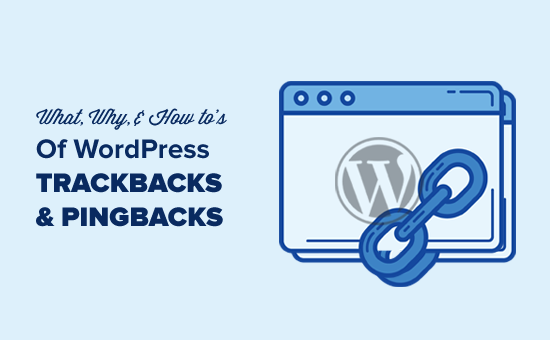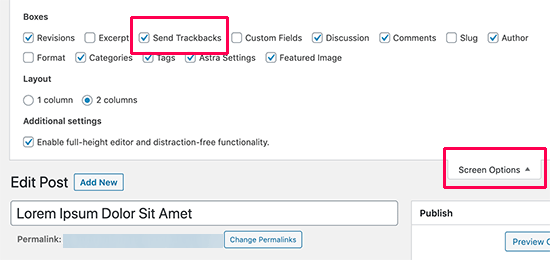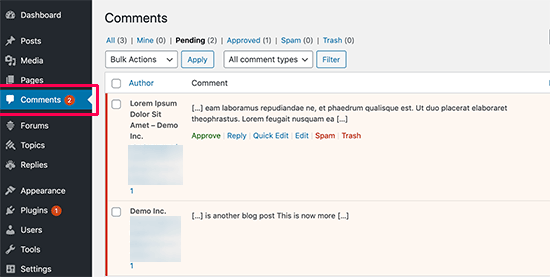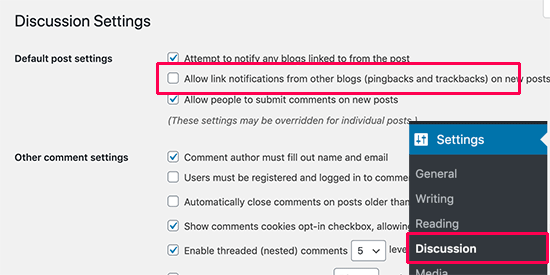Haben Sie schon einmal ‚Trackbacks‘ und ‚Pingbacks‘ in WordPress gesehen und waren verwirrt? Keine Sorge, das geht vielen Menschen so. Es handelt sich um WordPress-Blogging-Werkzeuge, die selbst einige erfahrene Benutzer nicht ganz verstehen.
Wir arbeiten seit langem mit WordPress und sind mit Trackbacks und Pingbacks gut vertraut. Sie können hilfreich sein, aber sie können auch Probleme verursachen. Sie wurden geschaffen, um Blogs zu helfen, miteinander zu kommunizieren, aber jetzt werden sie oft von Spammern missbraucht.
In diesem Leitfaden erklären wir, was Trackbacks und Pingbacks in einfachen Begriffen sind. Wir zeigen Ihnen, wie sie funktionieren und wie Sie sie nutzen (oder deaktivieren können, wenn Sie sie nicht wollen).

Verwenden Sie die nachstehenden Quick-Links, um durch die verschiedenen Themen in diesem Artikel zu navigieren:
Was ist ein Trackback?
Ein Trackback in WordPress ist wie eine freundliche Nachricht zwischen zwei Websites. Wenn eine Website einen Beitrag auf einer anderen Website erwähnt oder darauf verlinkt, sendet sie einen Trackback, um die andere Website darüber zu informieren. So funktioniert es:
- Angenommen, Sie schreiben einen WordPress-Beitrag. In Ihrem Beitrag enthalten Sie einen speziellen Link, eine so genannte Trackback-URL, zu einem anderen Beitrag auf einer anderen WordPress-Website. Es ist wie ein Geheimcode, der in den Informationen des verlinkten Beitrags zu finden ist.
- Wenn Sie Ihren Beitrag veröffentlichen, sendet Ihre Website einen Trackback an den Link, den Sie angegeben haben. Dieser Trackback enthält Details über Ihren Beitrag, wie den Titel und einen kurzen Text.
- Die andere WordPress-Seite empfängt Ihren Trackback und prüft, ob es sich um einen gültigen und relevanten Link handelt. Es handelt sich um eine freundliche Prüfung, um zu sehen, ob Ihr Beitrag gut zu ihrem passt.
- Wenn alles in Ordnung ist, wird der Trackback im Kommentarbereich des verlinkten Beitrags angezeigt. Er sieht ein wenig anders aus als normale Kommentare und zeigt normalerweise den Titel Ihres Beitrags und einen Ausschnitt seines Inhalts.
Was ist ein Pingback?
Ein Pingback in WordPress ist eine automatische Nachricht, die eine Website an eine andere sendet, wenn sie auf ihren Inhalt verlinkt. Hier sehen Sie, wie Pingbacks in WordPress funktionieren:
- Sie schreiben einen Beitrag mit einem Link zu einem anderen Beitrag auf einer anderen WordPress-Website.
- Wenn Sie Ihren Beitrag veröffentlichen, sendet Ihre WordPress-Website automatisch einen Pingback an die Website, auf die Sie verlinkt haben. Dieser Pingback enthält Details über Ihren Beitrag, wie den Titel und ein wenig Text.
- Die andere WordPress-Seite erhält Ihren Pingback und prüft, ob der Link gut ist und Sinn macht. Es ist eine freundliche Prüfung, um zu sehen, ob Ihr Beitrag gut zu ihrem passt.
- Wenn alles gut aussieht, wird der Pingback im Kommentarbereich des verlinkten Beitrags als Link zu Ihrer Website angezeigt.
Pingbacks funktionieren auch innerhalb Ihrer Website. Das heißt, wenn Sie auf einen Ihrer eigenen Artikel auf derselben Website verlinken, sendet WordPress automatisch einen Pingback an sich selbst.
Das nennt man Self-Ping, und wenn Sie anfangen, regelmäßig zu bloggen, werden Sie die Pings vielleicht als störend empfinden. Keine Sorge, sie lassen sich leicht abschalten, wie wir Ihnen später in diesem Artikel zeigen werden.
Was ist der Unterschied zwischen Trackbacks und Pingbacks?
Es gibt eigentlich keinen großen Unterschied zwischen Pingbacks und Trackbacks. Sie tun beide das Gleiche, verfolgen aber einen etwas anderen Ansatz.
Der erste Unterschied besteht darin, dass Trackbacks manuell erfolgen, während Pingbacks automatisch sind, da sie unterschiedliche Kommunikationstechnologien verwenden.
Zweitens wird bei Pingbacks nicht der Auszug des Beitrags gesendet, bei Trackbacks hingegen schon.
Wie man Trackbacks und Pingbacks in WordPress sendet
Seit WordPress 5.0 wurde die Möglichkeit, manuell einen Trackback an andere Blogs zu senden, aus dem Bildschirm des Block-Editors entfernt. Nur wenige Nutzer nutzen diese Funktion, und WordPress hat bereits standardmäßig automatische Pingbacks aktiviert.
Wenn Sie jedoch den klassischen Editor verwenden, ist die Funktion immer noch vorhanden. Bearbeiten Sie einfach einen Beitrag im klassischen Editor, und Sie finden die Option zum Senden von Trackbacks unterhalb des Bearbeitungsbereichs.

Wenn Sie das Trackback-Metafeld im klassischen Editor nicht finden können, klicken Sie auf die Schaltfläche „Bildschirmoptionen“ in der oberen rechten Ecke des Bildschirms.
Sie müssen das Kästchen neben der Option „Trackbacks senden“ ankreuzen, damit WordPress ein Feld für das Senden von Trackbacks unterhalb des Bearbeitungsbereichs anzeigt.

Wie man Pingbacks und Trackbacks in WordPress moderiert
Nach unserer Erfahrung sind 99 % aller Trackbacks und Pingbacks Spam. Dies ist der einfachste Weg für Spammer, einen Backlink von Ihrer Website zu erhalten.
In unserem Fall sehen wir häufig Pingbacks von Content Scrapern (Content-Dieben), die unsere gesamten Artikel Wort für Wort kopieren, einschließlich aller Links.
Aufgrund dieser Links sendet ihre Blogging-Software automatisch Pingbacks zu unseren Artikeln.
Die wenigen Male, in denen wir Trackbacks/Pingbacks als hilfreich empfunden haben, waren, wenn seriöse Blogger auf uns verlinkten. Sie haben uns sogar geholfen, herauszufinden, dass wir in Mashable und NYTimes vorgestellt wurden.
Kurz gesagt, wir haben festgestellt, dass 99 % aller Trackbacks/Pingbacks Spam sind. Das ist der Grund, warum wir sie vollständig deaktiviert haben. Es ist die Zeit nicht wert, eine Tonne Spam zu moderieren.
Es gibt auch andere Möglichkeiten, um herauszufinden, wer auf Ihre Artikel verlinkt hat. Am einfachsten ist es, Google Analytics zu verwenden, um herauszufinden, wer auf Ihre Website verlinkt.
Wenn Sie dennoch Trackbacks und Pingbacks verwenden möchten, sollten Sie sie auf Spam überprüfen. Dazu müssen Sie im WordPress-Verwaltungsbereich zu Einstellungen „ Diskussion gehen.
Aktivieren Sie dann im Abschnitt „Bevor ein Kommentar erscheint“ das Kontrollkästchen „Kommentar muss manuell genehmigt werden“. Dadurch wird sichergestellt, dass Trackbacks und Pingbacks nicht automatisch angezeigt werden und auf Spam geprüft werden müssen.

Sie können dann in den WordPress-Kommentarmoderationsbereich gehen, um nach ausstehenden Pingbacks und Trackbacks zu suchen.
Von hier aus können Sie sie genehmigen, löschen oder als Spam markieren.

Trackbacks, Pingbacks und Self Pings deaktivieren
Wenn Sie es leid sind, spammige Trackbacks und Pingbacks zu erhalten, dann gibt es eine Möglichkeit, diese vollständig zu deaktivieren.
Gehen Sie einfach auf die Seite Einstellungen “ Diskussion und deaktivieren Sie die Option „Link-Benachrichtigungen von anderen Blogs zulassen (Pingbacks und Trackbacks)“.

Wenn Sie dieses Kästchen deaktivieren, werden Trackbacks und Pingbacks nur für künftige Beiträge deaktiviert (nicht für bestehende Beiträge).
Um Trackbacks für bestehende Beiträge zu deaktivieren, müssen Sie unsere Anleitung zum Deaktivieren von Trackbacks und Pingbacks für bestehende WordPress-Beiträge befolgen.
Wenn Sie es leid sind, dass Ihr Blog sich selbst anpingt, können Sie einfach das Plugin No Self Pings installieren und aktivieren. Weitere Details finden Sie in unserer Schritt-für-Schritt-Anleitung für die Installation eines WordPress-Plugins.
Nach der Aktivierung deaktiviert das Plugin Self-Pings auf Ihrer WordPress-Website.
Bonus: Grundlegende WordPress-Kenntnisse für Einsteiger
Trackbacks und Pingbacks sind zwar spezielle Funktionen, aber es gibt noch viel mehr über die Grundlagen von WordPress zu lernen. Hier sind einige hilfreiche Anleitungen, um Ihr WordPress-Wissen zu erweitern:
- Wenn Sie WordPress als Herausforderung empfinden, sind Sie nicht allein. Lesen Sie, warum WordPress schwierig sein kann, und erfahren Sie Tipps, die es einfacher machen.
- Es ist wichtig, sich in WordPress zurechtzufinden. Erfahren Sie , wie Sie Beiträge, Kategorien, Schlagwörter, Kommentare oder Benutzer-IDs in WordPress finden können.
- Die effektive Verwaltung Ihrer Inhalte ist wichtig. Entdecken Sie , wie Sie Ihre gespeicherten Entwürfe in WordPress finden, damit Sie Ihre laufenden Arbeiten nicht verlieren.
- Wenn Sie die Leistung Ihrer Website verstehen, kann Ihr Blog reibungslos laufen. Finden Sie heraus, wie Sie in WordPress Speicherplatz freigeben und die Inode-Nutzung reduzieren können.
- Es ist wichtig, dass Ihre Website immer auf dem neuesten Stand ist. Erfahren Sie , wie Sie Ihr WordPress Theme anhand der neuesten Standards testen können.
Wir hoffen, dass dieser Artikel Ihnen geholfen hat, mehr über WordPress Trackbacks und Pingbacks zu erfahren. Vielleicht interessiert Sie auch unsere Anleitung für Anfänger zum Deaktivieren von Funktionen in WordPress und unsere Expertenauswahl der besten Plugins zur Verwaltung eines WordPress-Blogs mit mehreren Autoren.
Wenn Ihnen dieser Artikel gefallen hat, dann abonnieren Sie bitte unseren YouTube-Kanal für WordPress-Videotutorials. Sie können uns auch auf Twitter und Facebook finden.





Muhammad Atif
Hi, There is mistake under „what is pingback“, 4th point “ we „wikk“
WPBeginner Support
Thank you for catching that, we will get that typo fixed soon!
Admin
Iftekhar Bhuiyan
Helpful post indeed. Thank you.
On a personal level though, I stopped using it for quite some time now.
Marcia
I’m curious is it weird to approve self-pings? Internal linking is still a good thing but would there be any cons//would it just look weird? Thanks!
WPBeginner Support
It’s a bit of a personal preference question. It adds more admin tasks for you to do with the links to approve and you already have an internal link to cause the pingback so most do not find value in allowing self pings.
Admin
Christopher Wilson
I am so glad I discovered this website because it make everything so crystal clear especially if you are a beginner (I guess that’s why it’s named appropiately). I love it.
WPBeginner Support
Glad you found our content helpful
Admin
Mithu A Quayium
What about the real blogger who don’t spam. Don’t you accept their trackback/pingback then , even though they are legit ?
LaShaun W
Are there any advantages to approving a trackback. I just got one and I don’t know if I should or shouldn’t approve it. If someone clicks it, I risk losing a visitor, don’t I?
WPBeginner Support
Hi,
Yes, you can delete it.
Admin
Philip
Thank you for explaining TrackBacks.
I got two but the commenters name etc looked false and immediately raized the alarm.
So, if they do copy your article word for word, no one should panick, because Google will not give that copied post good ranking and they will hurt their website rankings! Or, am I missing something more important here?
I will disable trackbacks.
Thanks.
WPBeginner Support
Hi Philip,
Yes, you got that right. However, if you notice that someone with stolen content is outranking your articles in Google, then you can file DMCA and Google will remove those results. For more information, please see our guide on how to prevent blog content scraping in WordPress.
Admin
Sherry
Thank you so much for Tweeting this article! I just last week received 6 Pingbacks and had no idea what to do about them.
I had just moved from Blogger to WordPress.org earlier this year and I have been learning the platform and had never heard of Trackbacks and Pingbacks until last week.
I watched Your talk with Micheal Hyatt and learned so much too. I’m so glad I subscribed to Platform University and heard about your site it has been so helpful. I’m implementing a lot of the things you talked about with Micheal Hyatt.
Sherry
Editorial Staff
Thank you so much for the kind words Sherry. I’m happy to help
-Syed
Admin
Sinea
Thanks for the explanation. I would instantly stop all trackbacks and pingbacks if I were more experienced. I’ve been blogging for 7 years but only just moved from Blogger to WP. THANK GOODNESS FOR YOUR WEBSITE. Without it, I do not know what I would do!
I host two blog hops. I love meaningful comments from my guests at the parties as well as on other posts. Will disabling trackbacks or pingbacks interfere with my parties or real commentary? If it won’t, I’m disabling immediately. Another question… on existing spammy comments, is it better to mark them as spam or send them to the trash?
WPBeginner Support
Hi Sinea,
Thank you for kind words, we are glad that you find WPBeginner helpful. To answer your questions:
1. No, disabling pingbacks and trackbacks will not affect comments on your website.
2. It is better to mark spam comments as spam.
Admin
Sinea
Well, then, I will be disabling them! Thanks so much!
Sin Yee
Thanks for the explanation. Finally know what both of them are!
Janine
Thank you for addressing this! Honestly its a confusing topic. I recently had my post pinged back upon. (How on earth would one say that!?!)
I noticed that when she pinged me her post (in wordpress) automatically used my featured image for the post I had written.
I have pinged a different blogs post (not a wordpress blog) today and I don’t see if there is a way to include the image.
Is it still pinging if it is not a wordpress blog? Could that be what is different?
Thanks!
Tapiwa Zvakavapano
Greetings
I see there is an unanswered question in all this; If I do not approve a Pingback, will the link still work. I am afraid I am not as fawning as all the other people above. I run a recently launched blog; Network Bees and I have lots of links to your pages. All of them are genuine, ie, I read your articles and link to relevant, well written materials.
It worries me therefore, that all that effort is for nought because you are labeling all my links as spam. I may be confused about the whole thing, however. I think one of the comments above asked the same issue. Does disabling pingbacks and trackbacks mean that people cant link to a page? Or do the links still work nevertheless?
One of the things that I have discovered is that established bloggers tend to be a bit „detached“ when it comes to interacting with new bloggers. There is this blog that allows guest posts but does not allow even a single link to the author’s blog! I mean, what would be the point? In any case, that’s a digression. My question is above….
WPBeginner Support
Hi Tapiwa,
When you link to another WordPress powered website, the link on your website will work just fine. If the site you are linking to has the pingbacks and trackbacks disabled, then they will not see the link in their moderation queue and will not be able to mark it as spam. You should keep working on your blog as you normally would.
Admin
Michelle Belanger
Thanks for this article and your site!
I got a rather generic comment with a link to a site in the UK that had content unrelated to my blog post (a garden photo post linked to a job seeking website). i approved the comment initially because I want people to read and respond to my posts. After reading this article, I went in and removed the links and left the comment by itself.
Is this method ever used as a way to break into someone’s site to hack it? Or is it just a way to get someone from another site to click their link and go to their site? Thanks again for your help with this subject.
WPBeginner Support
Hey Michelle,
Most links submitted in a comments are often spam. Some times these links can lead users to malicious websites. You need to carefully review comments before approving them. See our guide on how to deal with comment spam in WordPress for more information.
Admin
Arulmjoseph
Thanks for the information.
gumusdis
Perfect, Thanks for sharing these useful information with us.
Dattaraj
Very good article. Thanks for detailed explanation.
Liz Ziser
Great post! Thank you for sharing.
Personally, my confusion lies with moderation options. For example, if a legitimate blog links to my site, and I move it to „Trash“, is the link deactivated? i.e. It’s fine for them to link to me, but I don’t want the pingbacks displaying at the bottom of my post… so would this be the best selection?
I’d just like to better understand the consequence of each moderation selection: Approve, Unapprove, Trash, Spam, and Trash. What actually happens when each of these are selected.
Thanks a lot!!
ketul
hello i am confusion about pingback in my wordpress its affect on seo keywords?
Daren
Perfect! Been wondering about this for a while. Thanks for the focused „Don’t waster your time“ advice.
Nebu John Thaliyath
Really Helpfull. Thank You
Sanjay Kumarr
Now I have good knowledge of Trackbacks and PingBacks, trackbacks are mannual with contents and pingbacks are automated / software based both will 99% spam.
Your article is very good and clearly belongs to questions that I was trying to find.
Good websites and information as well.
WPBeginner Support
Hey Sanjay, glad you found it helpful
Don’t forget to join us on Twitter for more useful WordPress tutorials.
Admin
Vasu
This was very useful. Just the information what I was looking for.
thanks
Vasu
Amit
This is very useful information for me too. Actually i was very confused before this. When i research on my website, that one trackback post show there.
After read this knowledgeable article about trackback and pingback . my problem has been solve.
Breanna
So, are pingbacks/trackbacks bad or good to get?
Chris Webb
Great Post, very thorough explanation on what these two types of linking mechanisms do.
Phil Owens
Hi,
Considering your title is what, how, why, you haven’t explained how to create a trackback. I am a complete noobie to blogging, so treat me like an idiot
Brendan Hall
I was going to use track backs on our site. We tried them for a while and we were just inundated with spamming comment (of which this comment is not lol). In the end I decided that is was not worth using track back at all.
Pushkar Kathayat
How to make a pingback for another blog?
Heather
Does disabling trackbacks and pingbacks affect my sites SEO?
WPBeginner Support
No it does not.
Admin
Luke Ward
Hi, If I disable pingbacks/trackbacks as you’ve suggested, will that also stop internal pinkbacks?
Thanks
Heike Martin
Internal pingbacks can be avoided by making sure that the url used only shows the extension of the full url. Look at the url for this post. To avoid self-pings you want the link to only read „/beginners-guide/what-why-and-how-tos-of-trackbacks-and-pingbacks-in-wordpress/“. This info is from the make.wordpress site. To do this add the link and check in text editor mode and delete the domain portion of the url
Robert
Thanks for this article on trackbacks and pingbacks. I had been thinking of the advantages of allowing trackbacks from genuine bloggers but if your experience is that 99% comes from spam then I don’t think the 1% is worth it.
I think I will place a prominent notice advising bloggers to use the Contact Me form to request a link up.
James
Have been reading the release notes on 4.0.1, specifically the XSS vulnerability in comments which launches upon moderating comments.
I don’t suppose any one would know if the trace ping backs could be exploited in the same way.